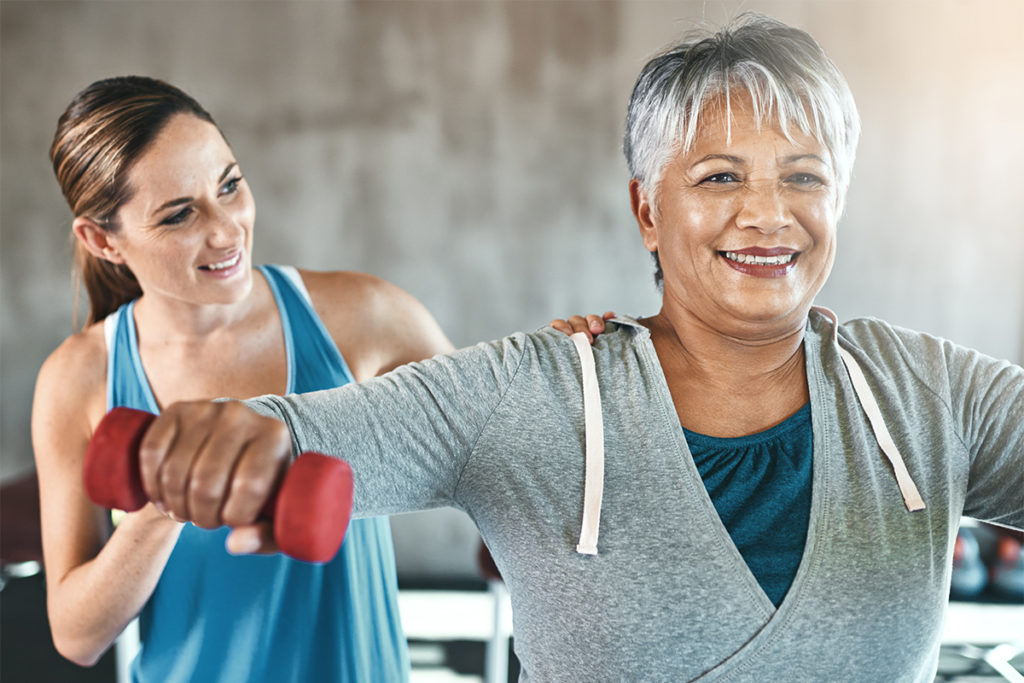Functional Training for Active Aging
Discover what type of exercise you need to enhance fitness as you grow older.

What’s driving the relevance of functional training? Loss of functional abilities significantly impacts life quality, according to Colin Milner, founder and CEO of the International Council on Active Aging in Vancouver, British Columbia. “Having a chronic health issue, like diabetes or high blood pressure, is manageable, but if you can’t stand up, everything changes.”
So how can you exercise for function? Shirley Archer-Eichenberger, JD, MA, internationally acknowledged integrative health advocate and mindful living educator, 30-year fitness industry veteran, and best-selling author of 16 fitness and wellness books, offers a brief overview of functional training methods.
What Is Functional Training?
The idea of functional training is [to do] a fitness program that mirrors common daily life activities, like getting out of a chair, making a bed, lifting laundry baskets, going shopping, gardening, etc.,” says Carol Ewing Garber, PhD, past president of the American College of Sports Medicine. “In older adults, as fitness declines . . . many find it increasingly difficult to do usual tasks or to engage in enjoyable activities.”
Progressive Resistance Training
Numerous studies show that progressive resistance training can improve functional capacity in older adults, including aspects of gait, balance and stability (Papa, Dong & Hassan 2017). It also benefits cardiovascular function, metabolism and heart disease risks (WHO 2015).
Increasingly, studies emphasize that muscle power—the ability to produce force rapidly—is more crucial to functional fitness than strength and mass are (Gianoudis et al. 2014). Also, researchers have suggested that exercises for the trunk muscles should be done to promote balance, functional performance and fall prevention (Granacher et al. 2013).
Dynamic Balance Training
Balance training may improve the safety of certain cardiovascular activities (WHO 2015). Researchers note that high-challenge balance training or programs that incorporate exercises that target both muscular and somatosensory balance systems have been most effective for reducing fall risks in older adults (Gianoudis et al. 2014).
Flexibility or Functional Mobility Training
The ability of joints to maintain full range of motion is highly relevant to enjoying functional independence in combination with muscular strength for tasks such as getting in and out of a bathtub. Very little research, however, has focused specifically on how to improve flexibility. Preliminary evidence suggests that activities like yoga, Pilates or tai chi—that involve movement through a full range of motion—are effective (Campos de Oliveira, Goncalves de Oliveira & Apgrecida de Almeida Pires-Oliveira 2016).
Cardiorespiratory or Functional Aerobic Training
Cardiovascular fitness is important for climbing stairs, going shopping and enjoying recreational activities; it also reduces cardiovascular disease risks and promotes mental well-being (Garber et al. 2011). Current research supports the physical activity guidelines of regular moderate- and vigorous-intensity exercise for those who can achieve it and regular light- to moderate-intensity activity for deconditioned persons, for health benefits.
About Activities of Daily Living
“Functional training combines aspects of multiple components because [in] activities of daily living, a movement might require flexibility and strength, or muscular endurance and aerobic fitness, or neuromotor fitness—balance, agility and coordination—and aerobic endurance,” says Carol Ewing Garber, PhD, past president of the American College of Sports Medicine. Functional exercises include pushing and pulling, rising and lowering, rotation, locomotion, and more.
Note: A certified personal trainer can help you develop a safe, effective functional training program.
References
Campos de Oliveira, L., Goncalves de Oliveira, R., & Apgrecida de Almeida Pires-Oliveira, D. 2016. Comparison between static stretching and the Pilates method on the flexibility of older women. Journal of Bodywork and Movement Therapies, 200 (45), 800–06.
Garber, C.E., et al. 2011. American College of Sports Medicine position stand. Quantity and quality of exercise for developing and maintaining cardiorespiratory, musculoskeletal, and neuromotor fitness in apparently healthy adults: Guidance for prescribing exercise. Medicine & Science in Sports & Exercise, 43 (7), 1334–59.
Gianoudis, J., et al. 2014. Effects of a targeted multimodal exercise program incorporating high-speed power training on falls and fracture risk factors in older adults: A community-based randomized controlled trial. Journal of Bone and Mineral Research, 29 (1), 182–91.
Granacher, U., et al. 2013. The importance of trunk muscle strength for balance, functional performance, and fall prevention in seniors: A systematic review. Sports Medicine, 43 (7), 627–41.
Papa, E.V., Dong, X., & Hassan, M. 2017. Resistance training for activity limitations in older adults with skeletal muscle function deficits: A systematic review. Clinical Interventions in Aging, 12, 955–61.
WHO (World Health Organization). 2015. World Report on Ageing and Health. WHO: Luxembourg.





